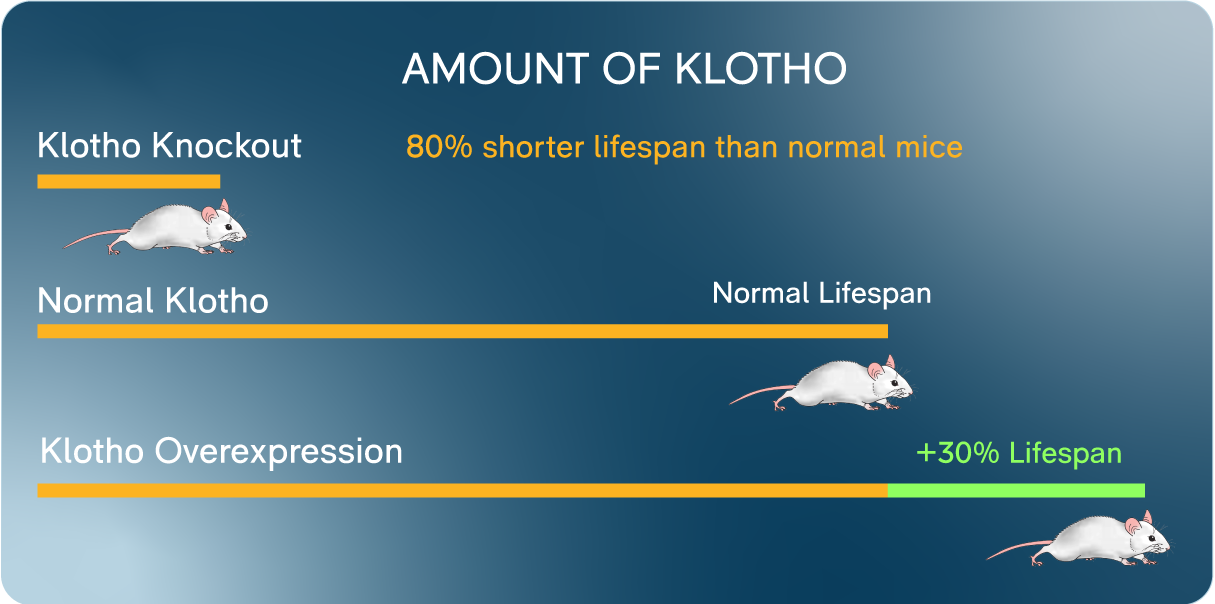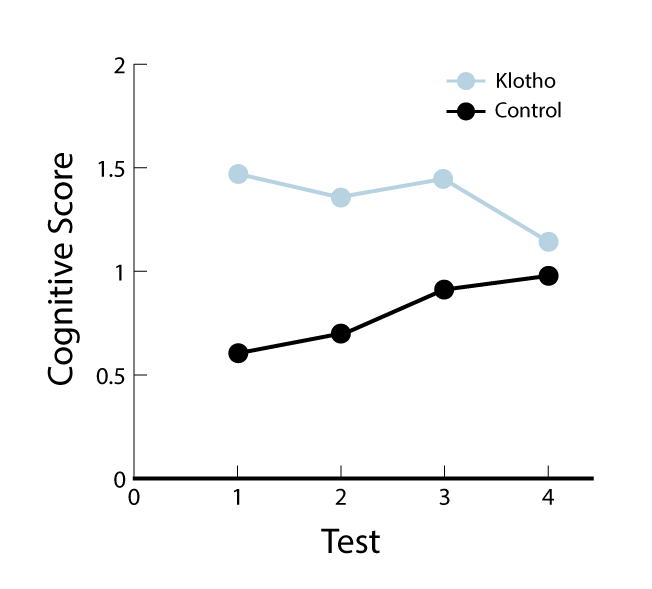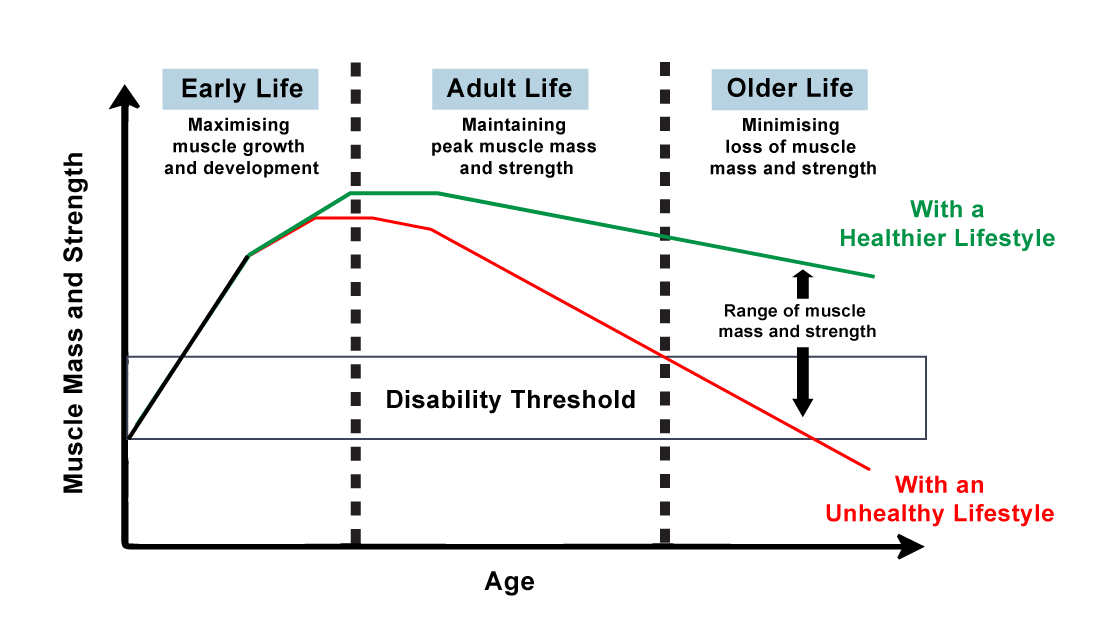Klotho is an anti-aging hormone detected in the brain, kidneys, urine, blood stream, and muscle. It is essential for a long, healthy life. Low Klotho levels have been associated with age-related disorders such as cardiovascular disease, diabetes, sarcopenia, and cognitive decline in both humans and laboratory animals.
The anti-aging benefits were originally discovered in Klotho genetic variants in mice and humans. The benefits have also been confirmed via Klotho injections in animals.
Klotho genetic overexpression in mice produced +30% longer life. Klotho genetic deficiency was shown to shorten life by 80%.

A single injection of Klotho in mice resulted in statistically significant improvement in spatial and working memory 2 days later.



Sarcopenia is the degenerative loss of skeletal muscle mass and function. This can include a decrease in force producing capacity, maximum velocity of shortening, and a general slowing of contraction and relaxation. Intimately linked to the decrease in muscle mass is a ‘metabolic dysregulation,’ which includes a reduction in insulin sensitivity, impaired oxidative defense, decreased mitochondrial function, changes in gene expression, and impaired endogenous regeneration. As the number and proportion of older persons in the population continues to escalate, sarcopenia will impact dramatically on quality of life and place ever-increasing demands on public health care.
Causes of Muscle Atrophy During Aging

During aging, the loss of muscle mass and strength is hypothesized to be due to the progressive atrophy of muscle fibers (McNeil et al. 2005) and a reduction in muscle ‘quality’ due to the infiltration of fat and other non-contractile material such as connective tissue.
Changes in muscle metabolism and insulin resistance (Conley et al. 1995; Cree et al. 2004) are also attributed to a complex interaction of many factors that affect neuromuscular transmission, muscle architecture, fiber composition, excitation–contraction coupling, and muscle metabolism (Plant and Lynch 2002).
Sarcopenia affects all elderly and does not discriminate based on ethnicity, gender, or social status. It can deprive a person of their functional independence and increase their risk for sudden falls and fractures (Szulc et al. 2005). On average, an individual’s muscle mass starts to decrease after the age of 50 at a rate of 1-2% every year, leading to a 1.5% decline in muscle strength between the age of 50 and 60. After the age of 60, muscle strength declines even faster at a rate of 3% per year (von Haehling et al., 2010).
Klotho is an anti-aging hormone detected in the brain, kidneys, urine, blood stream, and muscle. It is essential for a long, healthy life (Kuro-o et al., 1997; Kuroso et al., 2005). Age-related decreases in circulating Klotho levels have been reported to occur in humans, non-human primates, and rodents (Duce et al., 2008; Yamazaki et al., 2010). Low Klotho levels have been associated with age-related disorders such as cardiovascular disease, diabetes, sarcopenia, and cognitive decline in both humans and laboratory animals (John et al., 2011; Kuro-o et al., 2011; Vo et al., 2018).

Clinical studies have demonstrated that reduced Klotho levels are associated with a decrease in grip & knee strength (Semba et al., 2012; Semba et al., 2016) as well as increased frailty and exhaustion (Shardell et al., 2019) in elderly people. Physical activity increases plasma Klotho levels in young people, but not the elderly (Avin et al., 2014). The results demonstrate that low plasma Klotho levels are associated with an impaired knee extension strength in the study participants. Overall, the findings from this study suggest that plasma Klotho levels are strong predictors of skeletal muscle strength in elderly people.
Preclinical studies have demonstrated significant reductions in Klotho mRNA & protein levels in the aged mouse muscle due to hypermethylation of the Klotho promoter. The low Klotho levels in the muscle of aged mice lead to mitochondrial abnormalities, mitochondrial DNA damage and an increase in the production of reactive oxygen species. Klotho levels are upregulated in the muscle of young, but not aged mice following injury resulting in impaired muscle regeneration in aged mice. Treatment with Klotho protein significantly improves mitochondrial function, myogenesis & regeneration in the aged injured muscle (Ahrens et al., 2018; Sahu et al., 2018).
Klotho deficient mice exhibit significantly:
Reduced Klotho levels have also been associated with significant decreases in muscle strength and frailty in elderly people, aged mice, and Klotho mutants (Shardell et al., 2019; Ahrens et al., 2018; Sahu et al., 2018; Semba et al., 2016; Phelps et al., 2013; Semba et al., 2012). These animal studies have revealed some of the key cellular and molecular mechanisms via which Klotho mediates its effects on muscle health (Ahrens et al., 2018; Sahu et al., 2018; Phelps et al., 2013).
Their effects include:

Sarcopenia, the age-related loss in muscle mass and strength, is associated with a dysregulation in multiple signaling pathways. Different therapies consisting mainly of lifestyle changes such as physical exercise and diet have been proposed for the prevention and treatment of sarcopenia (Morley et al., 2008; Beaudart et al., 2017). However, because of the mechanistic complexity of sarcopenia, a combinatorial therapy targeting multiple cellular & molecular players would be the optimal treatment solution for affected individuals.

Treatment with recombinant Klotho protein significantly improves mitochondrial function, myogenesis, and muscle regeneration in the injured aged muscle (Ahrens et al., 2018; Sahu et al., 2018). Genetic overexpression of Klotho in mice strengthens forelimb grip and increases running endurance (Phelps et al., 2013). Considering these clinical & preclinical findings, future development of Klotho-based therapeutics for age-related muscle loss will represent an important step in the treatment of sarcopenia in elderly people.
We offer careers in a range of disciplines such as bioengineering and chemistry. Apply today.